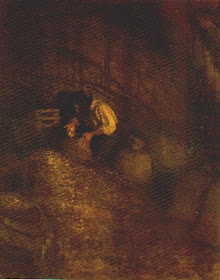 For my money, Dungeon Crawl Classics is the best system out there for Sword & Sorcery type gaming. But I want my game to take place in a persistent world, where player investment in each game session adds to a total lore that allows them to take control of the adventure and make it their own. I want the players, not the judge, to dictate that they shall try to steal gold from ancient Opar, or take the gates to old Barsoom, or travel to Shadrizar the Wicked, or seek a lost spell in the ruins of Melniboné.
For my money, Dungeon Crawl Classics is the best system out there for Sword & Sorcery type gaming. But I want my game to take place in a persistent world, where player investment in each game session adds to a total lore that allows them to take control of the adventure and make it their own. I want the players, not the judge, to dictate that they shall try to steal gold from ancient Opar, or take the gates to old Barsoom, or travel to Shadrizar the Wicked, or seek a lost spell in the ruins of Melniboné.Ideally for me, a game should consist of three types of adventures:
1. Persistent Locations: Areas that the PCs can learn about and choose to adventure in as a matter of course. This includes, of course, the exploration of the campaign milieu itself, and all manner of penetration in the the known and the unknown!
2. Opportunities: Things that happen at a particular time and offer a particular chance to adventure which can be taken or left, but which, if ignored, have consequences (even if those consequences are only that a particular opportunity is lost). For example, a ship crashing into a reef has some opportunity for rescue/exploration, but if the PCs do not recover the cargo, other parties will. Most of the published DCC adventures are of this nature.
3. Player-Initiated Quests: The PCs require something, and go out seeking it. This requires the ability to discover where the thing may lie, as well as the chance that it lies somewhere in the world to be discovered. The DCC core rulebook gives strong reason to include this sort of material, from the Quest For It advice to the need for wizards and elves to seek out new spells, and the need for clerics to seek the means to appease their gods.
The thing about Player-Initiated Quests is that they need to be tied into either a persistent location or an opportunity to adventure. For example, a desired new spell may always be in the ruins of the Castle of the Dragon Kings, or it may be placed by the judge to "hook" players into pitting their Blades Against Death, but the thing that the player(s) seek must exist in the milieu, either all of the time, or as the result of special circumstances. There is no point in telling the players they can seek out Stardock without placing Stardock in the campaign milieu, or placing some method to reach Nehwon in order to seek the mountain in its original continuum.
A megadungeon is not an area intended to be explored as the exclusive focus of a campaign milieu (or, at least, not necessarily) but rather a place where it is always possible to return. I.e., it is large enough, and complex enough, that it cannot be "used up" in a single adventure. There are many examples of megadungeons used in this way in Appendix N literature - from Moria in Lord of the Rings, to several complexes in the writings of Burroughs, Howard, Farmer, and Fox (among others), which are dipped into by their heroes for specific purposes, but never fully explored. In some cases, heroes of these stories do later return to some ruined pile in other adventures, giving a clear idea of how such a location can be used. Hell, there are even hints of megadungeons in Lovecraft.
Megadungeon play works very well with the Dungeon Crawl Classics ruleset. This is true even if one uses a megadungeon that was initially designed for another system - I have gotten excellent mileage out of Greg Gillespie's Barrowmaze and Barrowmaze II, initially designed for Labyrinth Lord. Versions of Moria designed for MERP and The Lord of the Rings RPG by Decipher are both easily adapted to DCC.
In the end, of course, the DCC-inspired megadungeon will reflect the DCC rules and design aesthetic, so that it might become the location of a number of quick forays over the course of a campaign, with lots of things to do, lots of places to see, and lots of secrets to uncover. Even where a megadungeon is the centre around which the campaign milieu revolves, other areas to explore, other people and monsters to oppose, and other opportunities that arise will send the PCs after pirates for one or more sessions, hunting man-apes for several others, and so on, in addition to their forays into the Great Ruined Pile.
The more Appendix N fiction I read, the more I note that most Appendix N adventurers live in worlds with multiple ruined cities and potential megadungeons, from the vast ruins in the swamp of the Palood to the hidden tunnels of the Worms of the Earth.
And I find that good.
Very good indeed.


.jpg)











